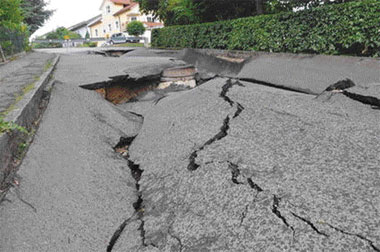|
In Focus

Running water:
1. Where do rivers start?
2. What are spits?
3. Why do waterfalls occur?
4. What are tributary rivers?
5. What is a Baymouth Bar?
Heart and blood:
1. What is plasma?
2. How much blood do we have?
3. What are blood groups?
4. How often does the heart beat?
5. What is the heart made of?
Galaxies:
1. What is a galaxy?
2. What are double stars?
3. What is a spiral galaxy?
4. How many galaxies are there?
5. What is the Milky Way?
[Answers]
Running water:
1. Some rivers start at springs where ground water reaches the
surface. There are rivers that start at the ends of melting glaciers and
others at outlets of lakes.
2. Waves and currents transport sediments along coasts. In places
where the coasts change direction, the worn sand and pebbles pile up in
narrow ridges. These ridges are called spits.
3. When rivers cross hard rocks, waterfalls can occur. When softer
rocks downstream are worn away, the hard rocks form a ledge over which
the river plunges in a waterfall.
4. Rivers that flow into a main river are called tributary rivers.
This swells the amount of water in the main river and increases its load
of worn material.
5. When spits join one headland to another they are called baymouth
bars. They can cut off bays from the sea, turning them into lagoons.
Heart and blood:
1. The yellowish liquid which comprises half of the blood in our
bodies is called plasma. It is mainly water with molecules of digested
food and essential salts dissolved in it.
2. An average man has 5 to 6 litres of blood while an average woman
has between 4 to 5 litres. Children have less, depending on how tall or
heavy they are.
3. The blood in our bodies is put into four main groups: A, B, AB and
O. Out of these, only some groups can be mixed with others. So, during a
medical emergency, doctors find out which blood group a patient belongs
to, before giving blood transfusion.
4. The heart beats 70 times per minute in an adult and about 80 times
per minute in a child. When we engage in some strenuous activity, such
as dancing, running or cycling, it beats faster than normal. This is to
send more blood to the muscles.
5. The heart is made of a special kind of a muscle known as the
cardiac (heart) muscle which never gets tired.
Galaxies:
1. Our Sun is just one of the massive collection of 200 billion stars
arranged in a shape like a fried egg, about 100,000 light years across.
This collection is called the Galaxy because we see it in the band of
stars across the night sky known as the Milky Way. Galaxy comes from the
Greek word for ‘milky.’ Earlier this century, it was realised that the
Galaxy is just one of billions of similar giant star groups scattered
throughout space, which we also call Galaxies. The nearest such Galaxy
is Andromedia.
2. Double stars are called binaries. Our Sun however is a lone star
but many stars have one or more nearby companions.
3. A Galaxy that has spiralling arms of stars like a gigantic
Catherine Wheel is called a spiral Galaxy. They (the stars) trail
because the Galaxy is rotating. Our Galaxy is spiral.
4. Currently there are estimated to be about 125 billion Galaxies in
the universe - there may be many more.
5. The pale, blotchy white band that stretches right across the night
sky is called the Milky Way. From Earth we get only an edge-on view of
it. A powerful telescope shows that it is made up of millions of stars.
Method to warn of earthquakes
discovered?
Researchers the world over are seeking reliable ways to predict
earthquakes, focusing on identifying seismic precursors that, if
detected early enough, could serve as early warnings.
New research, published this week in the journal Applied Physics
Letters, suggests that ozone gas emitted from fracturing rocks could
serve as an indicator of impending earthquakes. Ozone is a natural gas,
a byproduct of electrical discharges into the air from several sources,
such as from lightning, or, according to the new research, from rocks
breaking under pressure.

Scientists in the lab of Raul A. Baragiola, a professor of
engineering physics in the University of Virginia School of Engineering
and Applied Science set up experiments to measure ozone produced by
crushing or drilling into different igneous and metamorphic rocks,
including granite, basalt, gneiss, rhyolite and quartz. Different rocks
produced different amounts of ozone, with rhyolite producing the
strongest ozone emission.
Some time prior to an earthquake, pressures begin to build in
underground faults. These pressures fracture rocks, and presumably,
would produce detectable ozone.
To distinguish whether the ozone was coming from the rocks or from
reactions in the atmosphere, the researchers conducted experiments in
pure oxygen, nitrogen, helium and carbon dioxide.
They found that ozone was produced by fracturing rocks only in
conditions containing oxygen atoms, such as air, carbon dioxide and pure
oxygen molecules, indicating that it came from reactions in the gas.
This suggests that rock fractures may be detectable by measuring
ozone.Baragiola began the study by wondering if animals, which seem “at
least anecdotally” to be capable of anticipating earthquakes, may be
sensitive to changing levels of ozone, and therefore able to react in
advance to an earthquake.
It occurred to him that if fracturing rocks create ozone, then ozone
detectors might be used as warning devices in the same way that animal
behavioral changes might be indicators of seismic activity.
He said the research has several implications.
"If future research shows a positive correlation between ground-level
ozone near geological faults and earthquakes, an array of interconnected
ozone detectors could monitor anomalous patterns when rock fracture
induces the release of ozone from underground and surface cracks," he
said."Such an array, located away from areas with high levels of ground
ozone, could be useful for giving early warning to earthquakes."
He added that detection of an increase of ground ozone might also be
useful in anticipating disasters in tunnel excavation, landslides and
underground mines.
- ScienceDaily |

